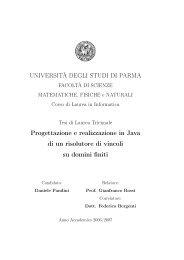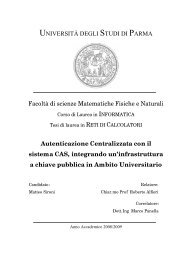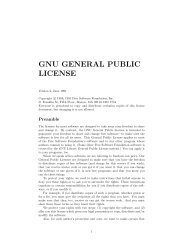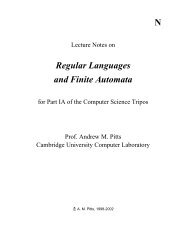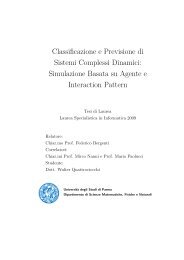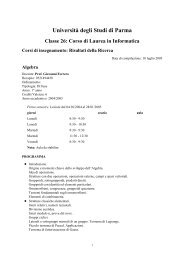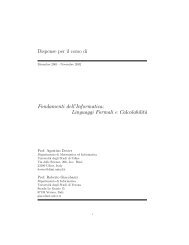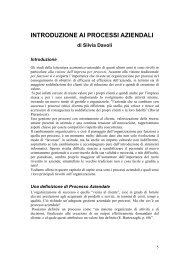A New Look at the Automatic Synthesis of Linear Ranking Functions$
A New Look at the Automatic Synthesis of Linear Ranking Functions$
A New Look at the Automatic Synthesis of Linear Ranking Functions$
- No tags were found...
You also want an ePaper? Increase the reach of your titles
YUMPU automatically turns print PDFs into web optimized ePapers that Google loves.
2. If (13) is feasible, let 〈ˇy, ˇµ〉 ∈ Q m+n be any <strong>of</strong> its feasible solutions.Choosing ˇµ for <strong>the</strong> values <strong>of</strong> <strong>the</strong> parameters, (11) is feasible. There aretwo fur<strong>the</strong>r possibilities:(a) ei<strong>the</strong>r (11) is unbounded, so (5) trivially termin<strong>at</strong>es;(b) or it is bounded by a r<strong>at</strong>ional q ≥ 1 and <strong>the</strong> same holds for itsdual (10).In both cases, ˇµ, possibly multiplied by a positive n<strong>at</strong>ural in order to geta tuple <strong>of</strong> n<strong>at</strong>urals, defines, via (7), a ranking function for (5).The above case analysis boils down to <strong>the</strong> following algorithm:1. Use <strong>the</strong> simplex algorithm to determine <strong>the</strong> feasibility <strong>of</strong> (13), ignoring<strong>the</strong> objective function. If it is feasible, <strong>the</strong>n any feasible solution inducesa linear ranking function for (5); exit with success.2. If (13) is unfeasible, <strong>the</strong>n try to determine <strong>the</strong> feasibility <strong>of</strong> (9) (e.g.,by using <strong>the</strong> simplex algorithm again to test whe<strong>the</strong>r <strong>the</strong> relax<strong>at</strong>ion (10)is feasible). If (9) is unfeasible <strong>the</strong>n (5) trivially termin<strong>at</strong>es; exit withsuccess.3. Exit with failure (<strong>the</strong> analysis is inconclusive).An example should serve to better clarify <strong>the</strong> methodology we have employed.Example 4.1. In <strong>the</strong> CLP(N) programp(x 1 , x 2 ) :− x 1 ≤ 1 ∧ x 2 = 0,p(x 1 , x 2 ) :− x 1 ≥ 2 ∧ 2x ′ 1 + 1 ≥ x 1 ∧ 2x ′ 1 ≤ x 1 ∧ x ′ 2 + 1 = x 2 , p(x ′ 1, x ′ 2),p(x 1 , x 2 ) is equivalent tox 2 ={⌊log 2 (x 1 )⌋, if x 1 ≠ 0;0, o<strong>the</strong>rwise.The relaxed optimiz<strong>at</strong>ion problem in LP not<strong>at</strong>ion (10) is 8minimize 〈µ 1 , µ 2 , −µ 1 , −µ 2 〉 T 〈x 1 , x 2 , x ′ 1, x ′ 2〉⎛⎞ ⎛ ⎞1 0 0 0 ⎛ ⎞ 2−1 0 2 0x 1subject to⎜ 1 0 −2 0⎜x 2⎟⎟ ⎝⎝ 0 1 0 −1⎠x ′ ⎠ ≥ −1⎜ 0⎟1 ⎝x0 −1 0 1′ 1 ⎠2−1〈x 1 , x 2 , x ′ 1, x ′ 2〉 ≥ 0,8 We will tacitly replace an equality in <strong>the</strong> form α = β by <strong>the</strong> equivalent pair <strong>of</strong> inequalitiesα ≥ β and −α ≥ −β whenever <strong>the</strong> substitution is necessary to fit our framework.14



